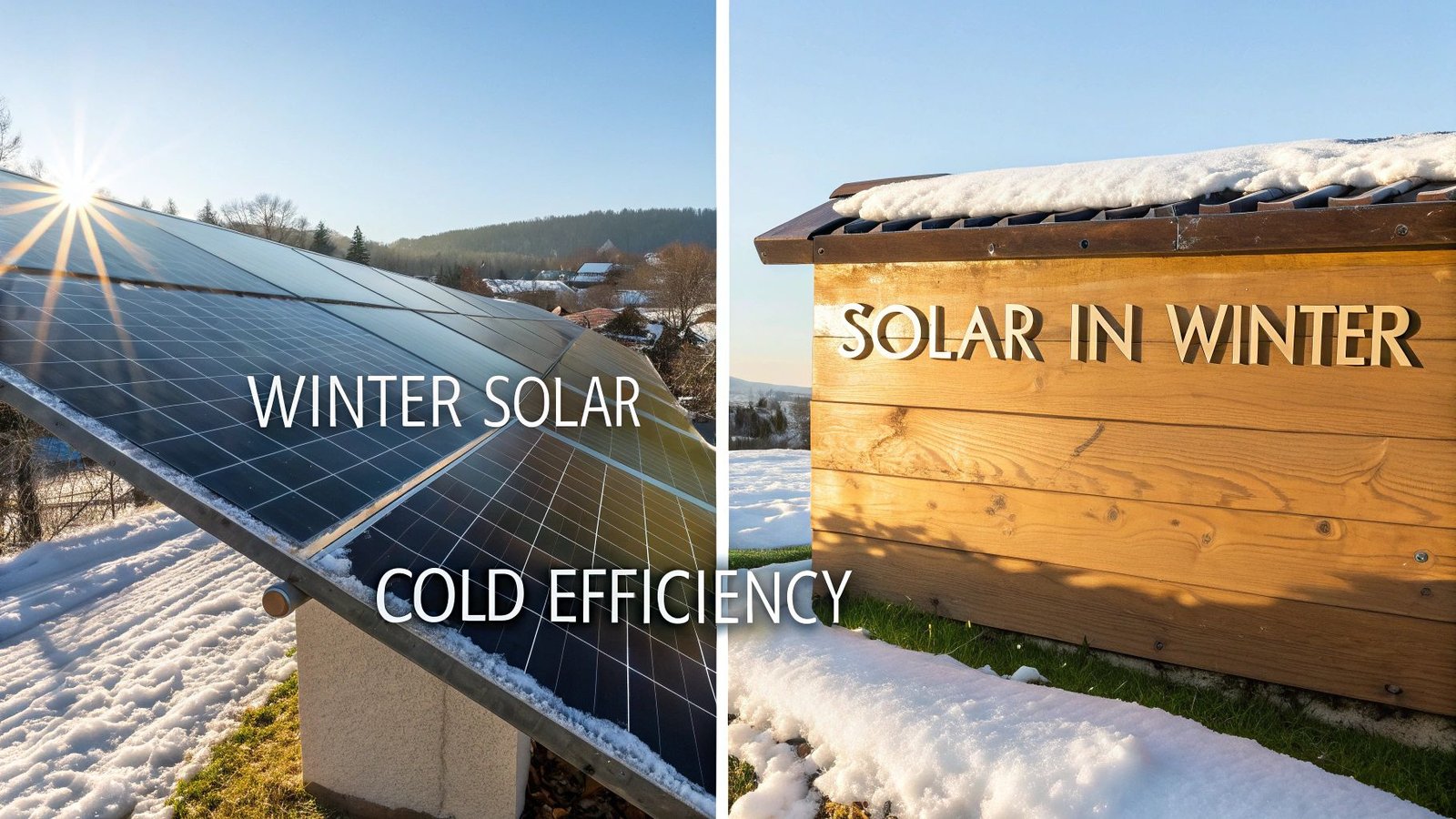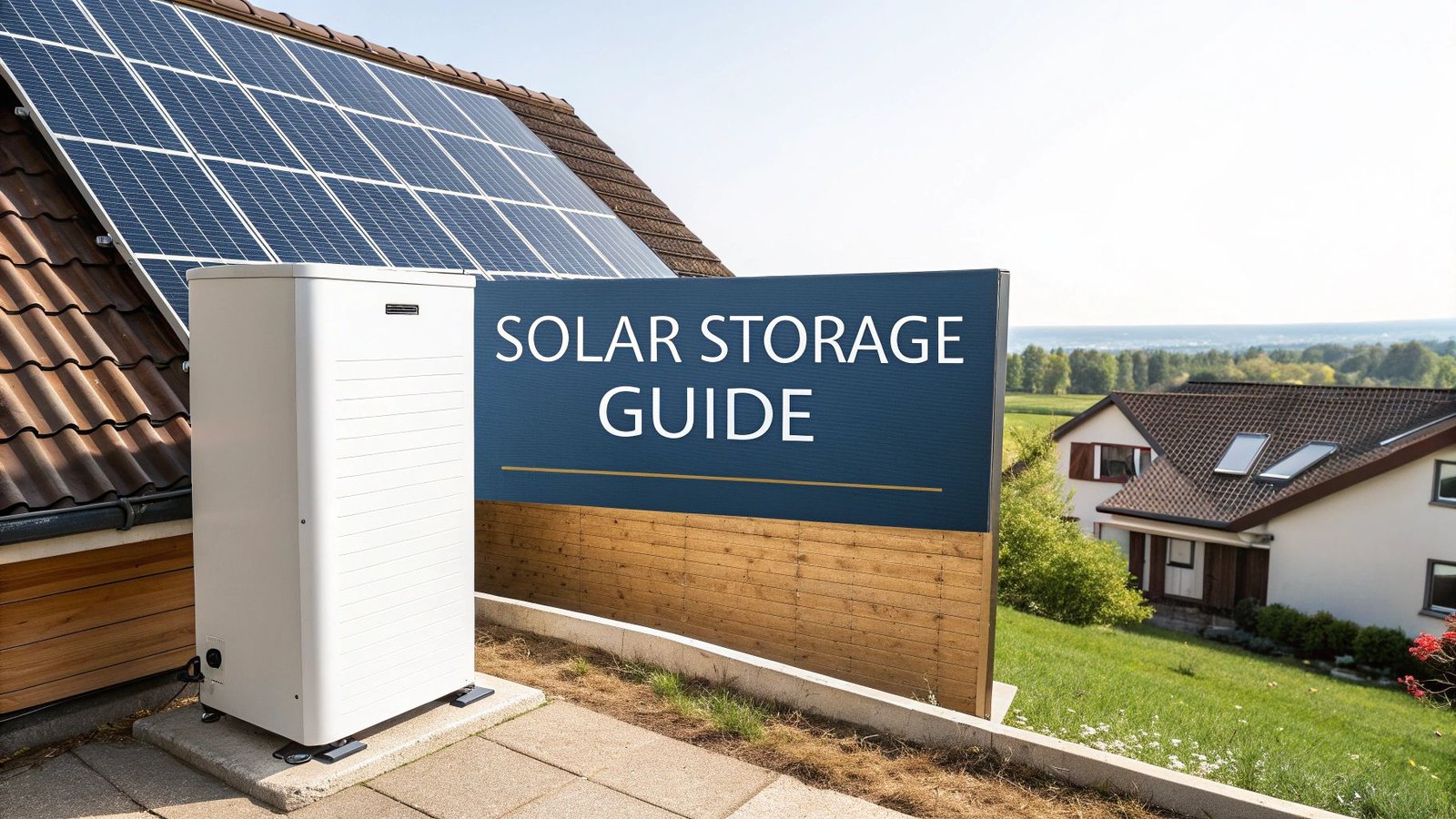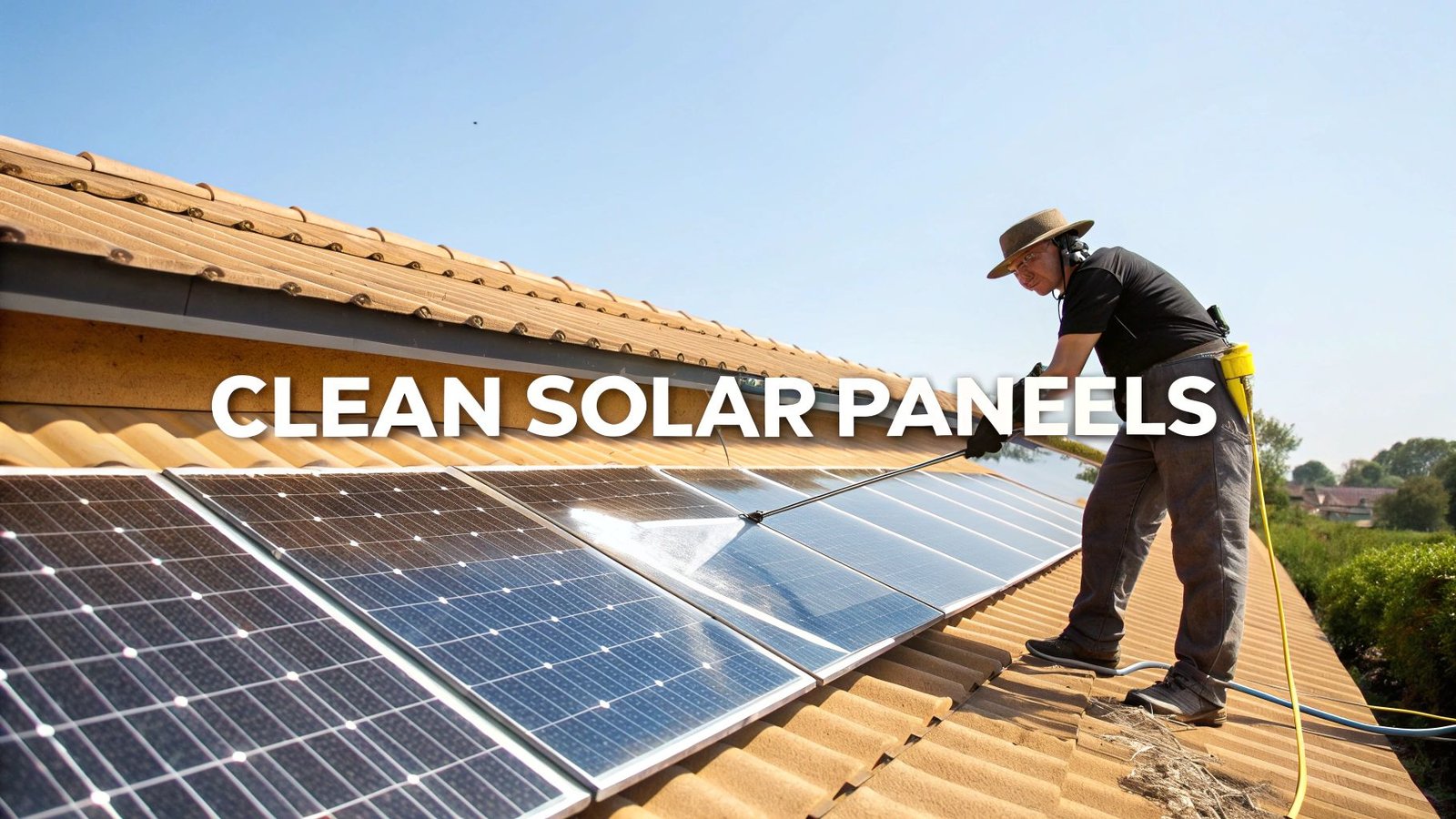It's one of the most common questions we hear: "Do solar panels even work in the winter?"
The answer is a resounding yes. In fact, in some ways, they actually work better. It’s a surprising twist that goes against the popular belief that solar power is only for hot, sunny climates.
The Surprising Truth About Solar Panels in Winter
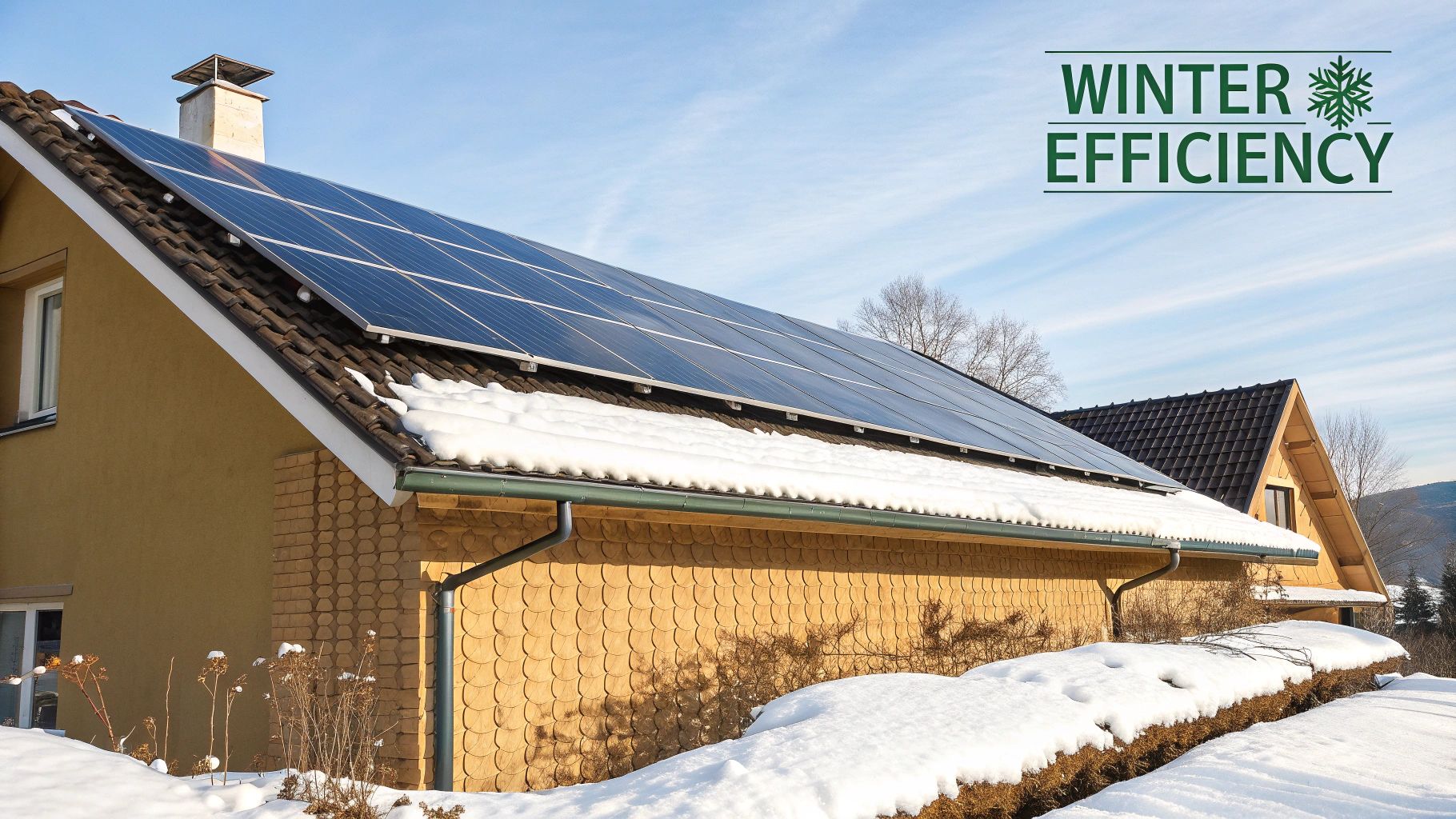
If you live in a place with a real winter, it's natural to question if a solar investment makes sense. The confusion usually comes from a simple mix-up: people assume solar panels run on heat. But they don't—they run on light.
Think about your phone or laptop. They run faster and happier when they're cool, right? Get them too hot, and performance starts to lag. Solar panels are just another piece of electronic equipment, and they behave the same way.
Why Cold is a Friend to Solar Panels
It might sound strange, but crisp, cold air actually helps your solar panels convert sunlight into electricity more efficiently. When the temperature drops, the electrical resistance inside the panel goes down. This lets the electrons, which are excited by sunlight, move around more freely. The result? More power from the same amount of light. This is a core principle of https://radiantenergysolar.com/how-does-home-solar-work/.
Here’s the key takeaway: Solar panels can perform up to 20% better in cold conditions compared to scorching summer heat. Manufacturers design them to handle extreme cold, often rating them for temperatures as low as -40°F, making them a perfect fit for even the harshest climates.
Understanding Winter Production
So if panels are more efficient in the cold, why is your overall production lower in January than in July?
It's not about the cold itself. The real culprits are two very simple, predictable factors:
- Shorter Days: There are simply fewer hours of daylight for your panels to soak up the sun.
- Lower Sun Angle: The sun hangs lower in the sky during winter, so its rays hit your panels at a less direct angle.
Even with those limitations, the technology is incredibly effective. Studies and real-world data consistently show that photovoltaic (PV) cells thrive in colder weather, boosting their energy conversion rates. This proves solar power's resilience in diverse climates, from sunny rooftops to adventurous solar-powered boats heading to Alaska.
Let's break down how different winter conditions really affect your system's output.
Winter Solar Performance at a Glance
This chart gives you a quick summary of how common winter conditions impact your solar panels.
graph TD
subgraph "Positive Factors"
A[Cold Temperatures] --> B[Improves Efficiency];
end
subgraph "Negative Factors"
C[Shorter Days] --> D[Less Production Time];
E[Lower Sun Angle] --> F[Less Direct Sunlight];
G[Snow Coverage] --> H[Blocks Light (Temporary)];
I[Cloudy Days] --> J[Reduces Light Intensity];
end
style A fill:#D4EDDA,stroke:#C3E6CB,stroke-width:2px
style B fill:#D4EDDA,stroke:#C3E6CB,stroke-width:1px
style C fill:#F8D7DA,stroke:#F5C6CB,stroke-width:2px
style D fill:#F8D7DA,stroke:#F5C6CB,stroke-width:1px
style E fill:#F8D7DA,stroke:#F5C6CB,stroke-width:2px
style F fill:#F8D7DA,stroke:#F5C6CB,stroke-width:1px
style G fill:#F8D7DA,stroke:#F5C6CB,stroke-width:2px
style H fill:#F8D7DA,stroke:#F5C6CB,stroke-width:1px
style I fill:#F8D7DA,stroke:#F5C6CB,stroke-width:2px
style J fill:#F8D7DA,stroke:#F5C6CB,stroke-width:1px
As you can see, the only real showstopper is a heavy blanket of snow. Everything else is just a normal part of the seasonal cycle, and modern solar systems are designed to handle it all with ease. Now, let's dive deeper into the science, challenges, and solutions for getting the most out of your panels year-round.
How Cold Weather Actually Boosts Solar Efficiency
It feels completely backward, doesn't it? Most people think solar panels need heat to work well, but the reality is just the opposite. Solar panels actually love the cold. A crisp, sunny winter day can be the perfect setup for your panels to perform at their absolute best.
Think of your solar panel like a high-performance engine. An engine gets its power from fuel, not from the heat it generates as a byproduct. In fact, too much heat can cause an engine to overheat and lose performance. Solar panels are the same way—they run on light, and excess heat just gets in the way.
The Physics of Cold Weather Performance
So what's actually going on inside that dark rectangle on your roof? Solar panels are built from semiconductors, which are engineered to kick electrons into motion when sunlight hits them. This flow of electrons is what creates an electrical current.
Here's the catch: heat creates resistance. When a panel gets too hot, the electrons get overly excited and start moving around randomly, which makes it much harder to create a strong, orderly flow of electricity. For every degree the temperature climbs above a standard 77°F (25°C), a panel’s voltage and overall power output actually drop slightly.
Cold weather, on the other hand, creates the ideal conditions. The cooler temperatures keep the electrons calm, reducing that internal resistance. When sunlight strikes, the energized electrons can flow much more freely and efficiently. This results in a higher voltage for the same amount of sunlight, meaning the panel is converting light into power more effectively.
Cold is a catalyst, not a barrier. Your solar panels don't just work in winter; their efficiency is fundamentally boosted by the chilly air, allowing them to produce more power per photon of sunlight.
Heat vs. Light: The Key Difference
To really get why winter isn't the enemy of solar, you have to separate two different things: heat (temperature) and light (irradiance).
- Heat (Ambient Temperature): This is just how hot or cold the air is. As we've covered, high heat hurts a panel's efficiency.
- Light (Solar Irradiance): This is the raw power of the sun hitting a surface. This is the fuel for your solar panels, and it exists whether it's 90°F or 20°F outside.
The chart below shows how a typical panel’s voltage reacts as the temperature drops. Voltage is a critical part of how much power you generate, and you can see it climb steadily as things get colder.
Panel Voltage vs Temperature
This graph illustrates the inverse relationship between panel temperature and voltage output. As it gets colder, the panel produces a higher voltage.
This is precisely why a bright but freezing January day can be a fantastic one for solar production. Sure, the shorter daylight hours mean you'll generate less total energy over the whole day. But during the hours the sun is out, your panels are working at peak efficiency, thanks to the cold.
This efficiency boost is a welcome advantage that helps make up for some of winter's other challenges.
Debunking Common Winter Solar Myths
Let's clear the air on a few common myths about solar panels in the winter. People often assume that once the clouds and snow arrive, their solar investment goes into hibernation. But the reality is far more optimistic.
A big one I hear all the time is that solar panels are useless on cloudy days. While it's true that direct, bright sunshine is the ideal scenario, panels don't just switch off when the sun ducks behind a cloud. They're built to capture both direct and diffuse sunlight—that's the light that scatters through the cloud cover.
So even on a gray, overcast winter afternoon, your system is still quietly producing power. Sure, the output will be lower than on a brilliant sunny day, but it’s a long way from zero. In fact, many modern, high-efficiency panels are specifically engineered to perform better in these low-light conditions.
The Surprising Boost from Snow
Another misconception is that any snow on the ground means game over for solar production. A heavy, wet blanket of snow will certainly block the light, no doubt about it. But a light dusting often melts or slides off pretty quickly, especially on a dark, tilted panel.
Here's where it gets interesting. Once your panels are clear, a snowy landscape can actually help your system.
This is thanks to something called the albedo effect. Fresh, white snow is incredibly reflective and acts like a massive mirror on the ground, bouncing sunlight that would otherwise be absorbed right back up onto your panels. This can give your production a small but meaningful bump, helping to counteract some of the effects of shorter days. This is a great example of how environmental factors play a role in energy systems, not unlike the cold weather performance myths in electric vehicles.
The takeaway here is that winter isn't the enemy of solar power. A snowy landscape, after the storm clears, can create an surprisingly productive environment for your panels.
This infographic gives a great visual of how summer and winter production compare, including that little boost you can get from snow.
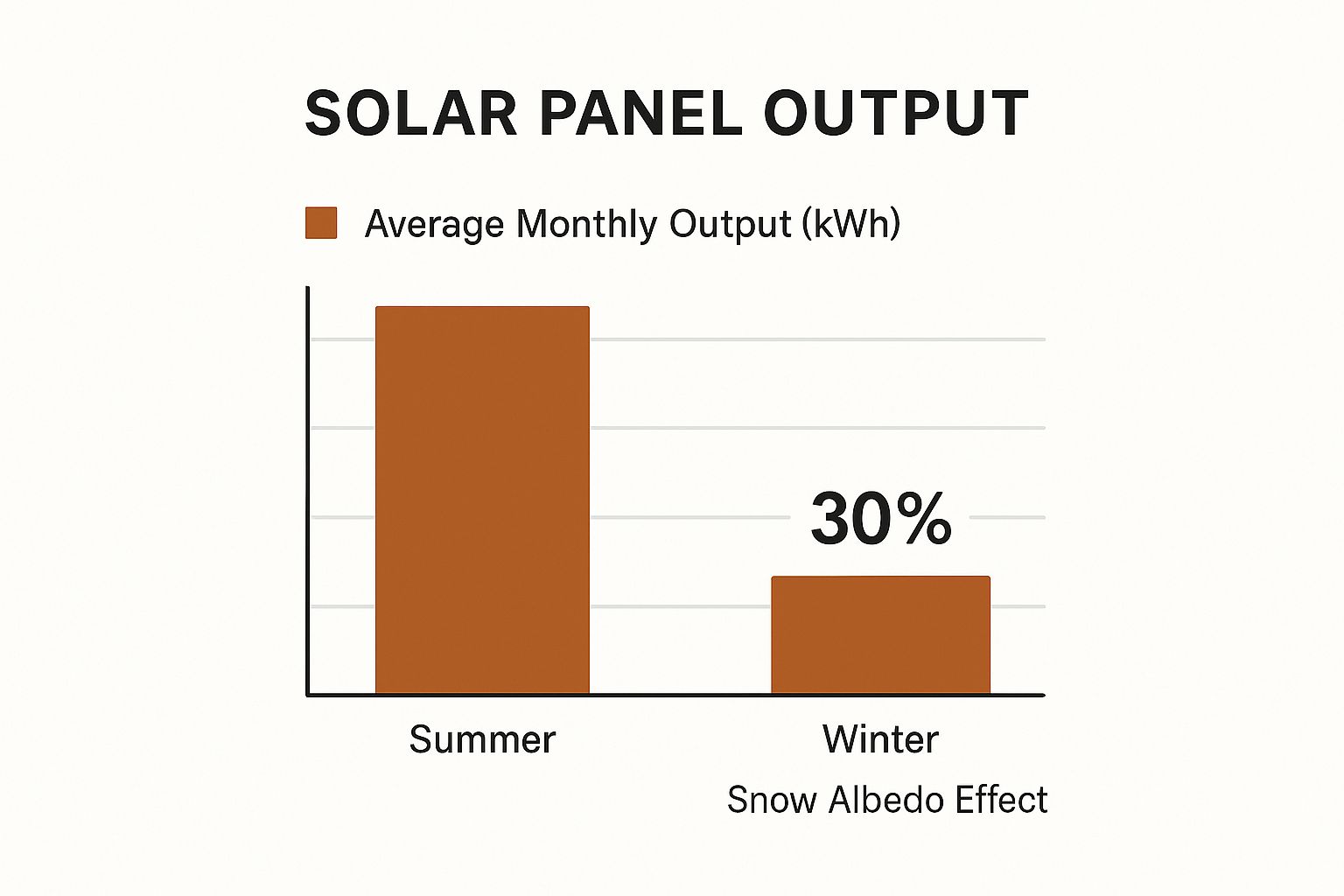
As you can see, it's a predictable seasonal dip, not a complete shutdown.
Real-World Winter Performance Data
So what kind of numbers are we actually talking about? Real-world data shows that modern solar panels are tougher and more effective in winter than most people think.
Even in places known for their notoriously gray winters, the production is still significant. Take a place like Portland, Oregon, for example. Research there shows that solar panels can still generate around 65% of their peak summer output during the winter months.
pie
title Solar Production in Winter (Portland, OR)
"Winter Output" : 65
"Seasonal Reduction" : 35
That’s pretty impressive, considering the shorter days and constant cloud cover. It really proves how well modern panels convert that diffuse sunlight into energy you can actually use.
At the end of the day, winter solar performance isn't a simple on-or-off switch. It’s a story of efficiency, physics, and surprising benefits. Your solar array is designed from the ground up to account for these seasonal shifts, ensuring it delivers value all year round.
Practical Ways to Manage Snow on Your Panels
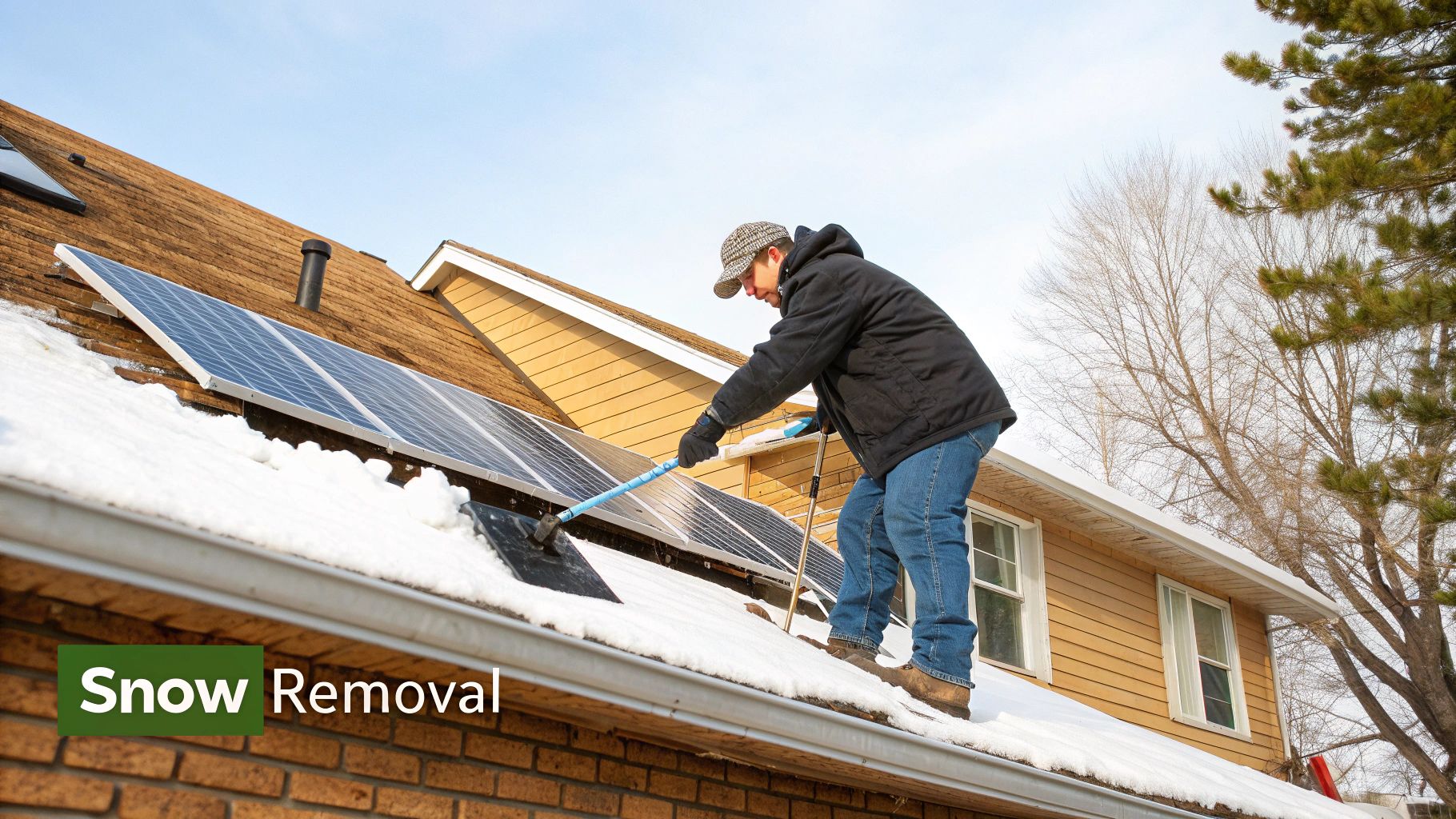
When the snow starts piling up, it’s easy to assume your solar production has ground to a halt. Many homeowners picture themselves having to climb a slippery roof after every storm, but the reality is thankfully much less dramatic.
Most of the time, the best approach is simply to wait.
Solar panels are built to shed snow on their own. Their dark, slick surfaces soak up any available sunlight, generating just enough warmth to melt the bottom layer of snow. Gravity then does the rest, and the blanket of white slides right off. The tilt of your array is a huge help here, too; a steeper angle means snow has a harder time sticking around.
So, When Should You Actually Step In?
The big question is, how do you know when it’s time to intervene? The rule of thumb is to be patient. If you’ve had a heavy, wet snowfall that’s been stubbornly sitting on your panels for a few days without any sun to help it along, then it might be time to consider clearing them.
But don't rush it. The data shows it's often not worth the effort or the risk.
A five-year study from the Northern Alberta Institute of Technology found that the total annual energy loss from snow was only about 3%. For most people, that tiny dip in production just doesn't justify the hassle and danger of clearing the panels.
Before you grab a ladder, weigh the small amount of lost energy against the very real safety risks of dealing with an icy roof. If you want a deeper dive, our complete guide to solar panels and snow removal breaks down the decision process even further.
How to Safely Clear Your Panels
If you’ve decided it’s absolutely necessary, the golden rule is to be gentle and stay on the ground. You can easily damage your expensive equipment—or yourself—if you’re not careful.
The Right Way to Do It:
- Use a Solar Panel Rake: This is your best friend. It’s a purpose-built tool with a soft, squeegee-like head on a long extension pole. You can stand safely on the ground and gently pull the snow off the panels without scratching them.
- Call a Professional: If your roof is too high or you’re just not comfortable with the task, hiring a pro is the smartest move. They have the proper safety gear and know-how to get it done right.
What You Should Never Do:
- Don't Use Hot Water: Throwing hot water onto frozen glass is a recipe for disaster. The sudden temperature change, called thermal shock, can create microcracks in your panels and cause permanent damage.
- Avoid Abrasive Tools: Stay away from metal shovels, stiff-bristled brooms, or anything that could scratch the panel’s surface. Damaging the anti-reflective coating will permanently hurt your system's performance.
- Stay Off an Icy Roof: This can't be stressed enough. The risk of a serious fall is far greater than the reward of a few extra kilowatt-hours of electricity.
Getting the Most Out of Your System in Winter
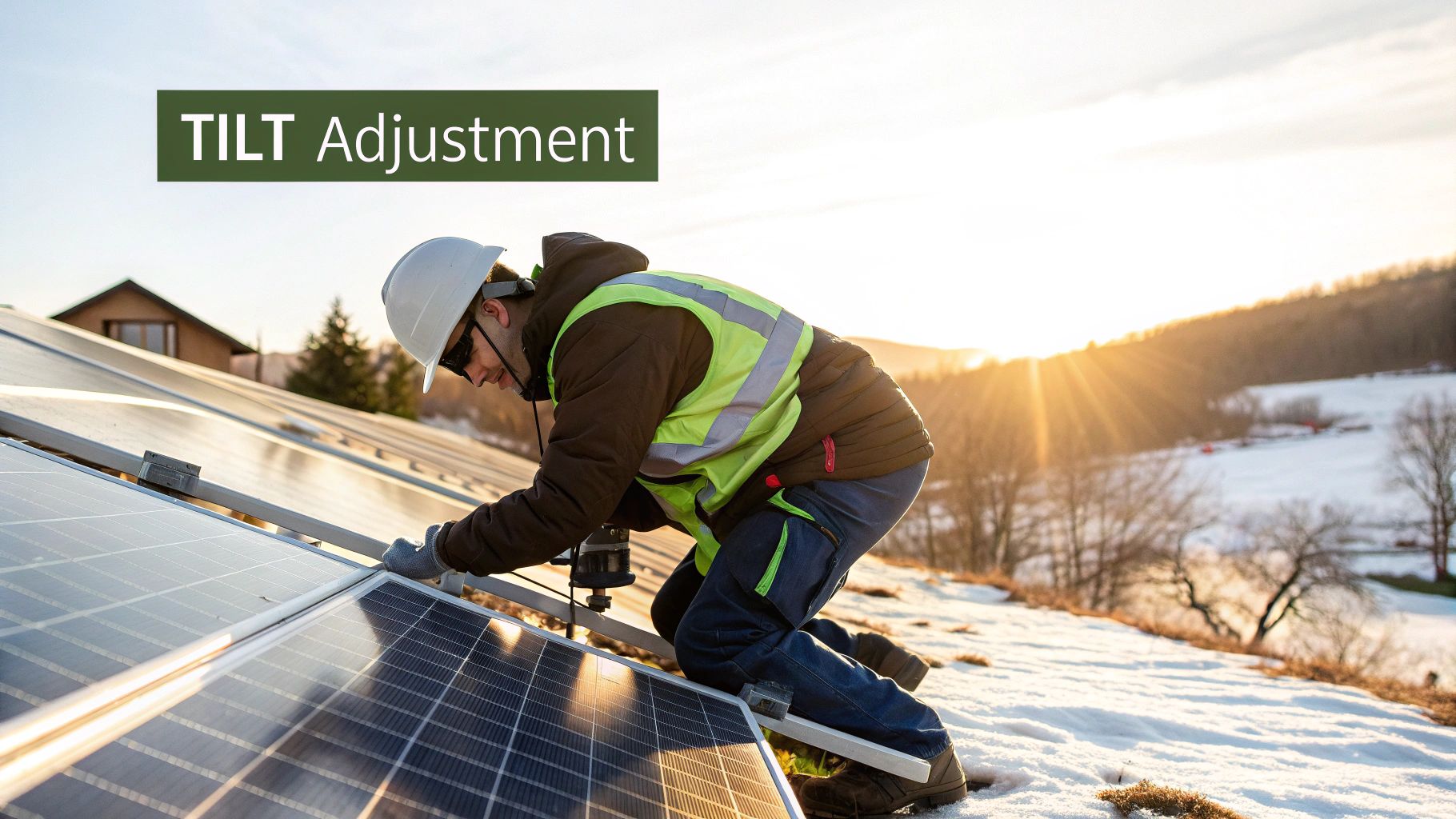
Clearing snow is one thing, but you can also design your solar array from the get-go to squeeze every last drop of energy out of those short winter days. It’s about more than just maintenance; the hardware you choose and how you set it up can make a huge difference in your system’s performance when it gets cold.
Think of it like setting the sails on a boat for the journey ahead. A few smart decisions during the design phase will position your panels to perfectly catch that low-hanging winter sun.
One of the most powerful moves you can make is adjusting the panel tilt angle. Since the sun travels lower across the sky in winter, a steeper angle allows your panels to face it more directly. This simple tweak not only boosts energy absorption but has the added bonus of helping snow slide right off.
Picking the Right Gear for the Job
Not all solar panels and components are built the same, especially when you're talking about performance in less-than-perfect weather. Some pieces of technology are just plain better at handling the unique challenges winter throws at them.
- Monocrystalline Panels: These are the efficiency kings, particularly in low-light conditions. Their uniform dark surface is fantastic at absorbing as much sunlight as possible, which makes them a go-to choice for areas with cloudy, overcast winters.
- Microinverters or Power Optimizers: If you live somewhere with snow, this is a game-changer. In a standard "string" inverter system, if just one panel gets covered by a patch of snow, it can tank the performance of the entire group. Microinverters and optimizers work on a panel-by-panel basis, so one snow-covered panel won't bring the whole party down.
The name of the game in winter optimization is resilience. When you choose components that can isolate and manage shading from snow, you're making sure one small problem doesn’t cause a system-wide slowdown. It's all about maximizing every single hour of sunlight you get.
Solar Isn't Just a Summer Fling
It’s easy to assume that winter makes solar a non-starter, but the reality is that solar energy works year-round all over the world. In fact, a staggering 93% of the world's population lives in places that get enough daily sunlight to make solar a viable option, even in the dead of winter. This just goes to show how effective solar panels can be in winter almost anywhere people live.
Even with the expected seasonal dip, the technology is more than capable of providing practical energy across the globe. By focusing on smart system design—the right hardware and the right setup—homeowners can get some seriously impressive results in the winter. For more tips and tricks, you can dive into our resources on solar panel optimization. This is how you make sure your investment keeps paying you back, no matter what month it is.
Common Questions About Winter Solar Performance
Even after getting the facts straight about how solar panels work in the cold, it's totally normal to have some practical, "what-if" questions. Let's tackle some of the most common things homeowners ask when they're thinking about going solar in a place with real winters.
How Much Less Energy Do Solar Panels Actually Make in Winter?
This is the big one, and the honest answer is: it depends on where you live. As a general rule of thumb, you can expect a solar panel system to generate about 40% to 65% of its peak summer output on a clear winter day.
This dip has nothing to do with the cold—it’s all about shorter days and the sun sitting lower in the sky. For instance, a system cranking out 40 kWh on a sunny July afternoon might produce somewhere between 16 kWh and 26 kWh on a crisp, clear day in December.
The key thing to remember is that any professional solar installer worth their salt already knows this. They model your system’s output using a full year of local weather data, so this predictable seasonal dip is already baked into their projections. You'll get a realistic picture of your annual energy savings from day one.
The graph below gives you a good visual of how this plays out over the year.
Average Daily Solar Production By Season
This chart shows the typical ebb and flow of energy generation, highlighting the expected drop during winter months.
Can Hail or Freezing Rain Wreck My Panels?
It’s easy to worry about durability when you see an ice storm rolling in. The good news is that modern solar panels are built like tanks.
High-quality panels are certified to withstand some serious punishment. We're talking about impacts from hail up to one inch in diameter hitting them at over 50 mph. That tempered glass they use is no joke.
Freezing rain is a bit different. While a thick sheet of ice will definitely stop production for a bit, it almost never causes physical damage. The best tool for the job here is patience. Just let the sun do its thing and melt the ice naturally. Whatever you do, don't try to scrape it off—you risk scratching the glass and permanently hurting your panel's performance.
Do I Need a Battery to Get Power in the Winter?
Nope, a battery isn't a requirement for your panels to work in the winter. A standard grid-tied system will keep generating power anytime the sun is out. That electricity directly reduces the amount of power you have to buy from the utility company, saving you money.
That said, adding a battery is a fantastic move if you want true energy independence. It lets you store the solar power you generate during the day and use it at night or—crucially—during a power outage. Since nasty winter storms can knock out the grid, a battery gives you the peace of mind that your lights will stay on no matter what.
Is Solar Even Worth It in Really Snowy or Cloudy Places?
Absolutely. You might be surprised to learn that some of the biggest solar adopters are countries known for their cold, overcast winters, like Germany. The real math behind a solar investment isn't based on a few perfect summer days, but on the total annual sunlight your location gets.
Even on the grayest, most overcast days, your panels are still working. They capture diffuse sunlight and will typically generate 10% to 25% of their rated output.
Your solar installer will crunch the numbers using decades of local climate data to give you a solid projection of your system's yearly production. The strong performance during the spring, summer, and fall is more than enough to make the investment pay off big time over the system's lifespan. You really don't need to live in a desert to make solar a smart financial decision.
Ready to see how solar can work for your home year-round? The team at Radiant Energy can provide a detailed, data-driven analysis of your property's solar potential, accounting for all four seasons. Visit Radiant Energy's website to get your free, no-obligation solar quote today and take the first step toward energy independence.

